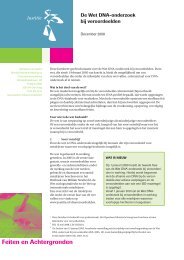INTERPOL HANDBOOK ON DNA DATA EXCHANGE AND PRACTICE
INTERPOL HANDBOOK ON DNA DATA EXCHANGE AND PRACTICE
INTERPOL HANDBOOK ON DNA DATA EXCHANGE AND PRACTICE
You also want an ePaper? Increase the reach of your titles
YUMPU automatically turns print PDFs into web optimized ePapers that Google loves.
THE USE OF POST-C<strong>ON</strong>VICTI<strong>ON</strong> <strong>DNA</strong> TESTING;THE UNITED STATES’ EXPERIENCEForensic <strong>DNA</strong> testing and state and national databases have been used retrospectivelyto re-examine evidence from historic, unsolved offences originating as far back as the1970s. In some circumstances this analysis has not only identified a suspect for the crimein question, but has proven the innocence of an already incarcerated person. In theUnited States through the New York (NY) Innocence Project 10 , based at the CardozoSchool of Law, NY, 217 persons have been exonerated (at 1 June 2008) following <strong>DNA</strong>testing of exhibits related to their original convictions. Collectively these men haveserved over 2,500 years in prison for crimes that they never committed, with theaverage jail term being in excess of 12 years. In 16 cases the death penalty had beenimposed before an individual’s innocence was proved. About 70% of those exoneratedwere members of minority groups. Additionally, in over 35% of cases involving postconviction<strong>DNA</strong> exoneration, the true perpetrator was also correctly identifiedthrough the use of <strong>DNA</strong> testing.As of July 2007, 42 states of the United States had some form of law permitting inmates’access to <strong>DNA</strong> testing, with the remaining eight states having no law granting suchaccess 11 . The legislative models vary in the extent of provisions they afford to inmatesseeking <strong>DNA</strong> re-testing. In some states all incarcerated felons are granted access topost-conviction <strong>DNA</strong> testing with the associated costs borne by state authorities. Inothers there are restrictions on the eligibility of certain inmates; for example, thosewho pleaded guilty or whose lawyers failed to request <strong>DNA</strong> testing at trial. In somemodels there are time limits on when an application can be made and the petitioninginmate must meet the cost of re-analysis. In some cases, the controversial evidencethat was used to convict a defendant at trial – such as eyewitness identification or‘’snitch testimony’’ – can also be used as grounds to deny a <strong>DNA</strong> test. As with all lawsthere is a need to strike a balance between the rights of incarcerated felons to havetheir convictions reviewed and the potential for misuse of state resources and theprotracted continuation of criminal matters.An important outcome of the numerous cases of post-conviction exoneration is theability to review the original cases and determine what led to the incorrect initial verdict.Saks et al. 12 and Liebman et al. 13 both presented data on failings identified followingpost-conviction review. Saks et al. cited data from 81 cases of wrongful convictionand reported that eyewitness identification (60), inadequate legal representation (55),and erroneous forensic science (53), were the features that most commonly led towrongful convictions. Liebman et al. focused only on capital cases and reported that“egregiously incompetent defence lawyers” accounted for 37% of the post-convictionPAGE 72THE USE OF POST-C<strong>ON</strong>VICTI<strong>ON</strong> <strong>DNA</strong> TESTING;THE UNITED STATES EXPERIENCE







